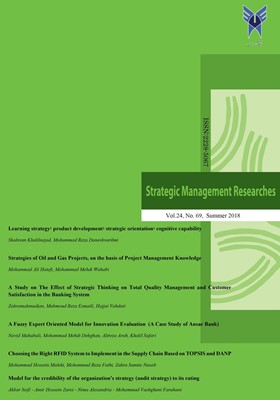Taxonomy of Promotion Strategies of the Prosperous Pharmaceutical Products in the Growth Stage
Subject Areas : Strategic Management Researches
Mahdi Ebrahimi
1
*
,
ali asgarhalvaei
2
![]()
1 - Assistant Professor of Business Management, Allameh Tabataba'i University of Tehran
2 - Deportment of business management, School of Management and Accounting, Allameh Tabataba'i University, Tehran, Iran
Keywords: Taxonomy, Promotion Strategies, Pharmaceutical Companies, Successful Pharmaceutical Products, Fuzzy Clustering ,
Abstract :
Iran's pharmaceutical industry has long been confronted with various marketing and advertising constraints Most of these constraints has arised from governmental terms and conditions, and has led to the overwhelming majority of these companies pursuing a passive and minimalistic approach to exploiting promotional strategies. However,today, with the arrival of newly stablished pharmaceutical companies and with private sector support, we are observing a remarkable change in the past approaches of these companies toward their promotion strategies. In this research, presenting the latest findings of promotion strategies of human pharmaceutical companies, we aimed to identify the common types of these strategies using the taxonomic method. For this purpose, we first created a comprehensive framework for the dimensions and components of the promotion strategy of pharmaceutical companies by conducting semi-structured interviews in a qualitative research and using a content analysis method ,then, through a quantitative survey and completion of questionnaires, the promotion strategy of each of the forty pharmaceutical companies in the statistical sample of this study was identified. Finally, by performing fuzzy clustering, four clusters or distinct types of promotion strategies of pharmaceutical companies were identified, each with significant differences in some of the key characteristics of other types. A key result of study shows that pharmaceutical companies have adopted different approaches to using promotion strategies.
Adams, C (2002). FDA Inundated Trying To Assess Drug Ad Pitches. Wall Street Journal B..
Benitez, T (2003). A Primary Concern, Incentive, 177 (2), 18-21.
Blech, G.E & Blech, M.A (2001). Advertising and Promotion. New York: NY: McGraw-Hill, Fifth Edition.
Carbonell, P & Rodriguez Escudero, A. I (2015). The negative effect of team’s prior experience and technological turbulence on new service development projects with customer involvement. European Journal of Marketing, 49(3/4), 278-301.
Duncan, T & Ouwersloot, H (2008). Integrated marketing communication- European edition.
Fill, C (2006). Simply marketing communications. Pearson Education.
Fine, L. M (2007). Selling and sales management. Business Horizons, 50(3), 185-191.
Hahn, G. J & Meeker, W.Q (1991). Statistical Intervals. John Wiley & Sons.
Johnson, R. B (1997). Examining the validity structure of qualitative research. Education, 118(2), 282.
Keller, K. L & Kotler, P. T (2015). Framework for Marketing Management. Pearson.
Kim, Y. A, Song, H. S & Kim, S. H (2009). A New Marketing Strategy Map for Direct Marketing. Knowledge-Based Systems, 22(5), 327-335.
otler, P (2003). Marketing Management: Analysis, Planning and Control. Englewood Cliffs, NJ: Prentice-Hall.
Kotler, P & Armstrong, G (1991). Principles of marketing fifth edition, New Jersey: Prentice Hall International Inc
.
Kotler, P & Keller, K. L (2012). Marketing management.
Krippendorff, K (2004). Content analysis: An introduction to its methodology.
Masterman, G & Wood, E. H (2005). InnovativeMarketing Communication: Strategyc for the events industry Routedge.
MATEI, Ş (2014). Promotion Strategies In Wine Marketing. SEA-Practical Application of Science, 2(2), 603-614.
Melewar, T. C & Vemmervik, C (2004). International Advertising Strategy; A Review, Reassessment And Recommendation, Management Decision, 42(7).
Montoya-Weiss, M. M & Calantone, R (1994). Determinants of new product performance: A review and meta-analysis. Journal of product innovation management, 11(5), 397-417.
Parker, R. S & Pettijohn, C. E (2006). Pharmaceutical drug marketing strategies and tactics: a comparative analysis of attitudes held by pharmaceutical representatives and physicians. Health Marketing Quarterly, 22(4), 27-43.
Prasad, A (2005). Jesus was born a Jew!: Strategy, religion and the product life cycle; The Journal of Business Perspective, 9(1), 37-46.
Sethi, R & Iqbal, Z (2008). Stage-gate controls, learning failure, and adverse effect on novel new products. Journal of Marketing, 72(1), 118-134.
Shih, H. A, Chiang, Y. H & Hsu, C. C (2013). High performance work system and HCN performance. Journal of Business Research, 66(4), 540-546.
Stemler, S (2001). An overview of content analysis. Practical assessment, research & evaluation. 7(17),137-46.
Tsekouras, G. E & Sarimveis, H (2004). A new approach for measuring the validity of the fuzzy c-means algorithm. Advances in Engineering Software, 35(8), 567-575.
Weber, M (1949). The methodology of the social sciences. Glencoe, IL: The Free Press.
Wilson, R & Gilligan, C (2005). Strategic Marketing Management Third.

